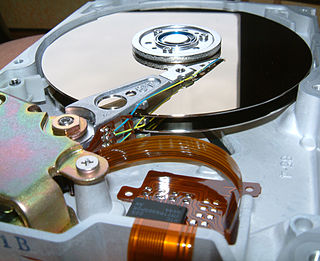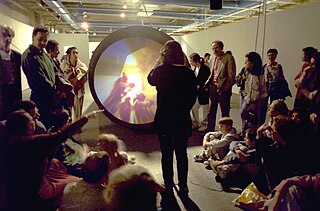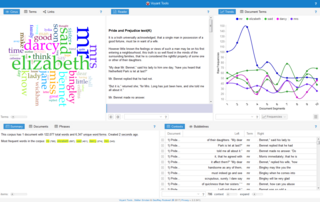
In mass communication, digital media is any communication media that operate in conjunction with various encoded machine-readable data formats. Digital content can be created, viewed, distributed, modified, listened to, and preserved on a digital electronics device, including digital data storage media and digital broadcasting. Digital defines as any data represented by a series of digits, and media refers to methods of broadcasting or communicating this information. Together, digital media refers to mediums of digitized information broadcast through a screen and/or a speaker. This also includes text, audio, video, and graphics that are transmitted over the internet for viewing or listening to on the internet.

Interactive art is a form of art that involves the spectator in a way that allows the art to achieve its purpose. Some interactive art installations achieve this by letting the observer walk through, over or around them; others ask the artist or the spectators to become part of the artwork in some way.

The MIT Press is a university press affiliated with the Massachusetts Institute of Technology (MIT) in Cambridge, Massachusetts. It was established in 1962.
Hybrid library is a term used by librarians to describe libraries containing a mix of traditional print library resources and the growing number of electronic resources.

Digitality is used to mean the condition of living in a digital culture, derived from Nicholas Negroponte's book Being Digital in analogy with modernity and post-modernity.

Digital humanities (DH) is an area of scholarly activity at the intersection of computing or digital technologies and the disciplines of the humanities. It includes the systematic use of digital resources in the humanities, as well as the analysis of their application. DH can be defined as new ways of doing scholarship that involve collaborative, transdisciplinary, and computationally engaged research, teaching, and publishing. It brings digital tools and methods to the study of the humanities with the recognition that the printed word is no longer the main medium for knowledge production and distribution.
Roy Ascott FRSA is a British artist, who works with cybernetics and telematics on an art he calls technoetics by focusing on the impact of digital and telecommunications networks on consciousness. Since the 1960s, Ascott has been a practitioner of interactive computer art, electronic art, cybernetic art and telematic art.

KIBLA or Kibla is the first multimedia and multidisciplinary art production facility in Slovenia, as well as a year-long cultural program. Kibla uses different media to maintain historical continuities in visual arts and integration of electronic and traditional media. It also incorporates classical (original) media in different contexts. It is a member of the Slavic Culture Forum. Kibla displays, distributes, and promotes the activity of 16 multimedia centers around Slovenia.

Mel Alexenberg is an American-Israeli artist, art educator, and writer recognized for his pioneering work exploring the intersections of art, science, technology and digital culture. He created the first digital computer generated painting in 1965, experimental digital fine art prints in the 1980s that are in 30 museum collections worldwide, circumglobal cyberangel flights honoring Rembrandt in 1989 and in 2019, and a dialogue between tactile artworks and NFTs. Alexenberg has educated generations of young artists as professor at Columbia University and universities in Israel, research fellow at MIT Center for Advanced Visual Studies, dean at New World School of the Arts in Miami, and head of the art department at Pratt Institute where he taught the first course on creating art with computers.

Oliver Grau is a German art historian and media theoretician with a focus on image science, modernity and media art as well as culture of the 19th century and Italian art of the Renaissance. Main Areas of Research are: Digital Art, Media Art History, immersion, digital humanities, documentation and conservation strategies of born-digital media art.

Edward A. Shanken is an American art historian, whose work focuses on the entwinement of art, science and technology, with a focus on experimental new media art and visual culture. Shanken is Professor, Arts Division, at UC Santa Cruz. His scholarship has appeared in numerous journals and anthologies and has been translated into many languages. Shanken is the author of Art and Electronic Media, among other titles.

Internet art is a form of new media art distributed via the Internet. This form of art circumvents the traditional dominance of the physical gallery and museum system. In many cases, the viewer is drawn into some kind of interaction with the work of art. Artists working in this manner are sometimes referred to as net artists.
Tom Corby and Gavin Baily (1970) are two London based artists who work collaboratively using public domain data, climate models, satellite imagery and the Internet. Recent work has focused on climate change and its relationship to technology and has involved collaborations with scientists working at the British Antarctic Survey.

New media art includes artworks designed and produced by means of electronic media technologies, comprising virtual art, computer graphics, computer animation, digital art, interactive art, sound art, Internet art, video games, robotics, 3D printing, and cyborg art. The term defines itself by the thereby created artwork, which differentiates itself from that deriving from conventional visual arts. New Media art has origins in the worlds of science, art, and performance. Some common themes found in new media art include databases, political and social activism, Afrofuturism, feminism, and identity, a ubiquitous theme found throughout is the incorporation of new technology into the work. The emphasis on medium is a defining feature of much contemporary art and many art schools and major universities now offer majors in "New Genres" or "New Media" and a growing number of graduate programs have emerged internationally. New media art may involve degrees of interaction between artwork and observer or between the artist and the public, as is the case in performance art. Yet, as several theorists and curators have noted, such forms of interaction, social exchange, participation, and transformation do not distinguish new media art but rather serve as a common ground that has parallels in other strands of contemporary art practice. Such insights emphasize the forms of cultural practice that arise concurrently with emerging technological platforms, and question the focus on technological media per se. New Media art involves complex curation and preservation practices that make collecting, installing, and exhibiting the works harder than most other mediums. Many cultural centers and museums have been established to cater to the advanced needs of new media art.
The Maryland Institute for Technology in the Humanities (MITH) is an international research center that works with humanities in the 21st century. A collaboration among the University of Maryland College of Arts and Humanities, Libraries, and Office of Information Technology, MITH cultivates innovative research agendas clustered around digital tools, text mining and visualization, and the creation and preservation of electronic literature, digital games, virtual worlds.

Ricardo Mbarkho, is a Lebanese contemporary artist, researcher, and assistant professor.

Ars Electronica Linz GmbH is an Austrian cultural, educational and scientific institute active in the field of new media art, founded in Linz in 1979. It is based at the Ars Electronica Center (AEC), which houses the Museum of the Future, in the city of Linz. Ars Electronica's activities focus on the interlinkages between art, technology and society. It runs an annual festival, and manages a multidisciplinary media arts R&D facility known as the Futurelab. It also confers the Prix Ars Electronica awards.
Media art history is an interdisciplinary field of research that explores the current developments as well as the history and genealogy of new media art, digital art, and electronic art. On the one hand, media art histories addresses the contemporary interplay of art, technology, and science. On the other, it aims to reveal the historical relationships and aspects of the ‘afterlife’ in new media art by means of a historical comparative approach. This strand of research encompasses questions of the history of media and perception, of so-called archetypes, as well as those of iconography and the history of ideas. Moreover, one of the main agendas of media art histories is to point out the role of digital technologies for contemporary, post-industrial societies and to counteract the marginalization of according art practices and art objects: ″Digital technology has fundamentally changed the way art is made. Over the last forty years, media art has become a significant part of our networked information society. Although there are well-attended international festivals, collaborative research projects, exhibitions and database documentation resources, media art research is still marginal in universities, museums and archives. It remains largely under-resourced in our core cultural institutions.″
Monika Fleischmann is a pioneering German research artist, digital media scientist, and curator of new media art. She is one of the most relevant European women artist working in art, science, and technology. She founded and co-founded departments for interactive media art such as ART+COM in Berlin, the MARS – Exploratory Media Lab and the eCulture Factory within the largest German research institutions such as GMD and Fraunhofer Society. In 1992, together with her partner Wolfgang Strauss, she received the Golden Nica of the Prix Ars Electronica in Linz, Austria for Home of the Brain (1990/1992), the first artistic virtual reality installation. She is the recipient of the 2018 ACM SIGGRAPH Distinguished Artist Award for Lifetime Achievement in Digital Art and was elected to the SIGGRAPH Academy as a research artist that has contributed to the field of interactive media art since the 1980s to the present day. Since the mid-1980s she has been working collaboratively with the architect Wolfgang Strauss as an artist couple. As part of their research in New Media Art, Architecture, Interface Design and Art Theory, they focus on the concept of Mixed Reality, which connects the physical with the virtual world. In 2008 she was appointed Honorary Professor of Media Theory and Interactive Media Art for the cross-university course of studies for digital media at Bremen University of Applied Sciences, Academy of Fine Arts and University of Bremen. Monika is Member of the MIMA ART Board at MIMA University | Munich Institute of Media and Musical Arts.












